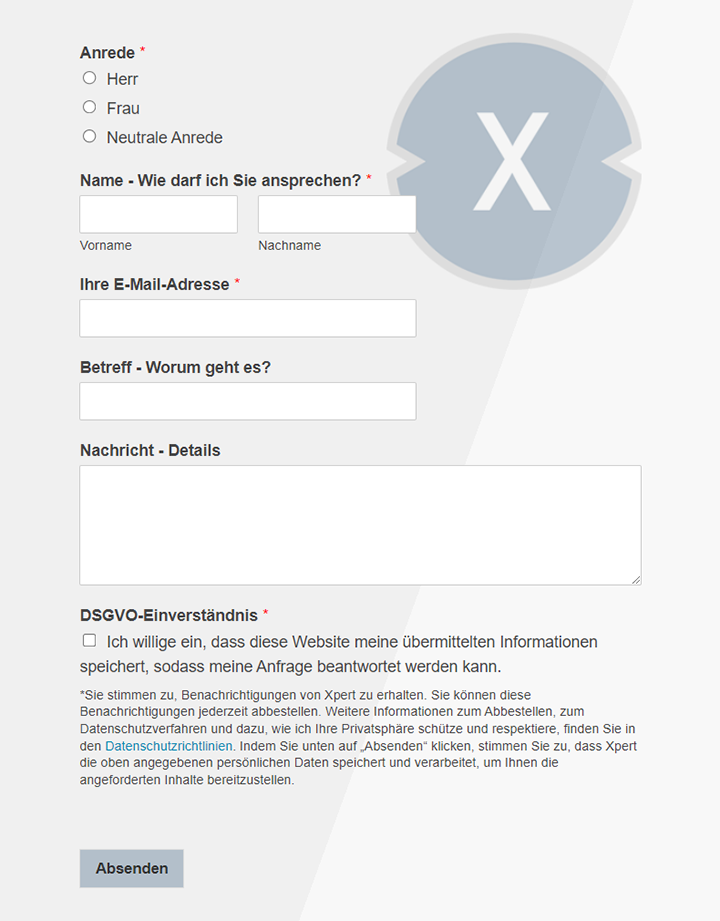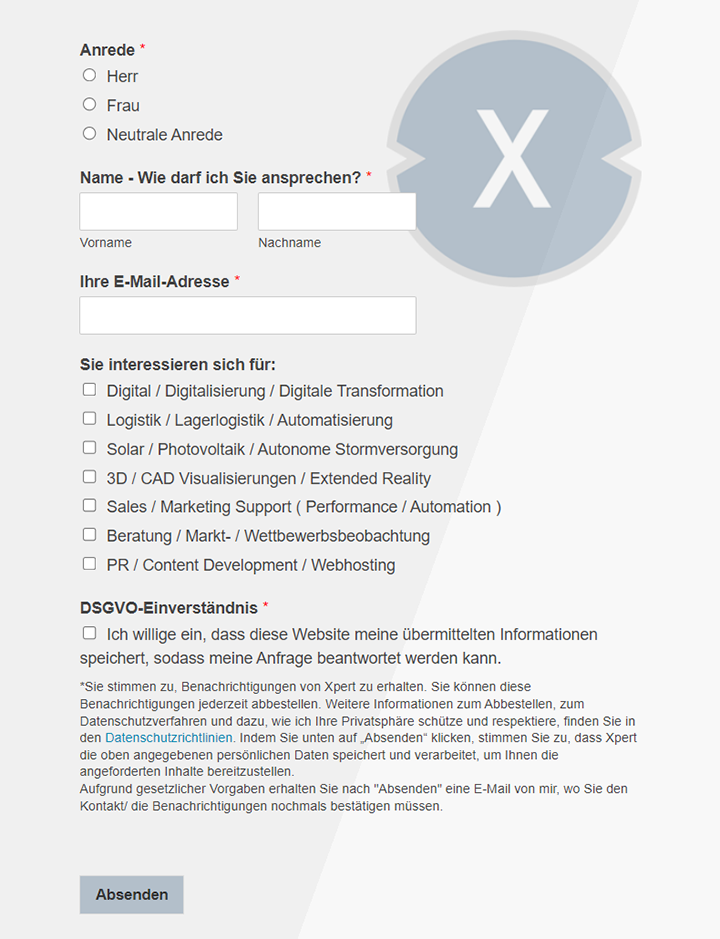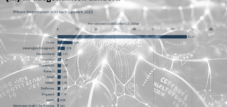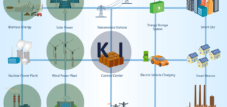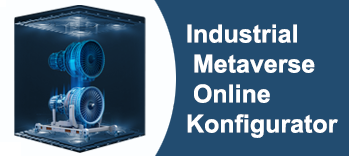Europe in the race for artificial intelligence and automation: strategies to strengthen competitiveness
Xpert pre-release
Language selection 📢
Published on: February 24, 2025 / update from: February 24, 2025 - Author: Konrad Wolfenstein

Europe in the race for AI and Automation: challenges and strategies for strengthening competitiveness - Image: Xpert.digital
Europe's robotic stumbles: How do we stay globally competitive?
Europe in the global race for artificial intelligence and automation: challenges, strategies and the way to strengthen competitiveness
The European robotics and automation industry is in a phase of profound changes and sees itself confronted with existential challenges that will significantly determine their future position in global competition. The most recent forecasts by the Association of German Machine and Plant Construction (VDMA) draw a worrying picture: For 2025, a drop in sales of 9 % is expected, which would reduce industry sales to 13.8 billion euros. This forecast decline is not only a short -term dent, but also indicates structural weaknesses and growing international competitive disadvantages that European industry meet in its core.
While other global actors, especially China and the United States, massively expand their positions in robotics and automation, Europe seems to be falling behind. China has almost doubled its robot density in recent years and is aiming for an even more aggressive expansion. The United States is increasingly relying on protectionist measures and massive state support programs to strengthen its domestic industry and to weaken foreign competition. In this dynamic and increasingly competitive environment, Europe urgently needs to act in order not to lose the connection and to preserve its technological sovereignty.
Suitable for:
The VDMA has recognized the urgency of the situation and presented a comprehensive “Robotics Action Plan for Europe”. This plan is a wake -up call to politics and business and requires targeted measures to strengthen innovative strength, to improve the scalability of companies and to increase the market penetration of European automation solutions. This report analyzes the essential drives of this crisis, highlights the global disparities in the area of robotics and automation and, based on the VDMA strategy, develops detailed recommendations for action that should lead Europe out of this difficult situation and strengthen its position in global competition sustainably.
Structural weaknesses of the European robotics industry: a look inside the challenges
The European, and in particular the German robotics and automation industry, which was able to achieve record sales of 16.2 billion euros in 2023, is facing a turning point. One of the largest structural weaknesses lies in the historically grown close dependence on the domestic automotive industry. This industry, once the engine of German and European economic growth, is in a profound transformation process. The switch to electromobility, the need for new drive technologies and the persistent global supply chain problems have led to considerable sales difficulties. Since the automotive industry is a main buyer of robotics and automation solutions, their problems have an immediate and significant demand for demand in the automation industry.
In 2024, domestic orders in robotics and automation broke up by alarming 16 %. The foreign business was able to compensate for this decline, but the fundamental weakness of domestic demand remains. Frank Konrad, the chairman of the VDMA, illustrates the situation with the words: “Invested customers are reluctant to invest. The German economy needs better framework conditions for a solid growth path. " This statement underlines the need for a comprehensive approach that not only strengthens the robotics industry itself, but also the entire economic ecosystem in Europe.
Another critical factor are the increasing regulatory loads and an innovation backlog that affects the agility and competitiveness of European companies. Dr. Dietmar Ley, the chairman of VDMA Robotik + Automation, criticizes the "exuberant regulation" and the high operating costs that the companies burden in Europe. While Chinese competitors are massively subsidized and push into the European market with aggressive strategies, European companies are faced with a complex network of bureaucratic hurdles that hinder the fast market launch of new technologies. This rage of regulation extends to various areas, from environmental requirements and data protection regulations to complex approval procedures for new production systems.
At the same time, however, the VDMA also warns of self -criticism within its own ranks. A lack of willingness of the member companies is criticized to shorten innovation cycles and implement customer -specific solutions faster. At a time when markets and technologies change faster, agility and responsiveness is crucial. European companies have to optimize their internal processes, respond faster to customer needs and invest more courageously in new technologies in order to be able to survive in global competition. The often cited German engineering and precision must be combined with a larger portion of entrepreneurial daring and joy of innovation.
Global competitive landscape: China and the USA as new power centers of the automation
In order to fully understand the challenges for the European robotics industry, a look at the global competitive landscape is essential. China and the United States in particular have developed into the dominant actors in the area of robotics and automation in recent years and are increasingly under pressure on Europe.
China's robotic offensive: a state, a vision, an industry conquers the world
China has launched an unprecedented robotic offensive in recent years, which is massively promoted by the government's 14th five-year plan. This plan focuses on the promotion of high technology clusters and the development of AI-based production. The results of this strategic orientation are impressive: Between 2019 and 2023, China's robot density in the processing industry more than doubled from 235 to 470 robots per 10,000 workers. China has already left the EU average (219 units) far behind and is aiming for an even higher robot density.
Dr. Ley warns urgently: “China shows how ideas are consistently transferred to industrial mass production. Europe loses the connection if we do not counteract. " This statement sums up the core problem. China is impressively not only to develop innovations, but also to implement them on a large scale in industry. This is achieved through massive government investments in research and development, targeted support programs for companies and a consistent industrial policy.
The Chinese government is pursuing a clear vision: China is said to rise to the global innovation leader in the area of robotics and automation. In order to achieve this goal, enormous resources are mobilized, talents are promoted and an innovation -friendly ecosystem is created. Chinese companies benefit from generous subsidies, an unbureaucratic regulatory environment and a huge internal market, which serves as a test field and springboard for global expansion.
American industrial policy: “America First” and the return of protectionism
The United States has also realigned their industrial policy in recent years and are increasingly relying on protectionist measures and massive state support programs to strengthen domestic industry. The "America First" agenda, which started under the previous US administration and continues under the current government, aims to prefer American companies and to push back foreign competition.
A central instrument of this policy is the "Chips and Science Act", a multi -billion dollar support program that specifically directs investments in the semiconductor industry and other key technologies in the United States. This law creates significant location advantages for American companies and at the same time disadvantage European competitors who do not benefit to the same extent from state support.
In addition, the United States is increasingly relying on trade restrictions and tariffs to keep foreign products away from the American market and increase demand for domestic products. These protectionist measures tighten global competition and also put European companies under pressure.
In response to trade conflicts with the United States, Chinese manufacturers of robotics and automation technology, such as Siasun and Estun, have increased their strategic efforts to penetrate the European market. They build local service structures, invest in sales networks and offer competitive products and solutions. This development shows that Europe not only has to compete with the United States, but also with an increasingly self -confident and innovative China.
🎯🎯🎯 Benefit from Xpert.Digital's extensive, fivefold expertise in a comprehensive service package | R&D, XR, PR & SEM

AI & XR 3D Rendering Machine: Fivefold expertise from Xpert.Digital in a comprehensive service package, R&D XR, PR & SEM - Image: Xpert.Digital
Xpert.Digital has in-depth knowledge of various industries. This allows us to develop tailor-made strategies that are tailored precisely to the requirements and challenges of your specific market segment. By continually analyzing market trends and following industry developments, we can act with foresight and offer innovative solutions. Through the combination of experience and knowledge, we generate added value and give our customers a decisive competitive advantage.
More about it here:
Secure technological sovereignty: four pillars for Europe's future
The VDMA action plan: Four pillars for Europe's technological sovereignty
In view of the challenges described and the intensifying global competitive landscape, the VDMA has developed a comprehensive “Robotics Action Plan for Europe”. This plan is based on four central pillars that aim to secure Europe's technological sovereignty in the field of robotics and automation and to strengthen the competitiveness of European industry sustainably.
1. European robotic offensive: secure independence, strengthen competitiveness
The first pillar of the action plan calls for a "targeted robotic offensive" that combines competitiveness, demographicity and climate neutrality. In essence, it is about creating a uniform regulatory framework in Europe, making cross -border cooperation facilitating and prioritizing the development and application of key technologies such as collaborative robots (cobots).
A uniform European legal framework would make it easier for companies to offer their products and solutions in all EU member states without having to deal with different national regulations and norms. This would reduce bureaucracy, reduce costs and accelerate the market launch of new technologies.
The prioritization of key technologies such as cobots is of crucial importance, since these robots will play a key role in the future industry. Cobots are collaborative robots that can safely work with people and thus open up new opportunities for automation in areas in which conventional industrial robots cannot be used due to security concerns. The promotion of cobots would enable European companies to develop innovative automation solutions and to strengthen their competitiveness in various industries.
2. Risk capital mobilization for start-ups: promote innovations, enable growth
European start-ups in the area of robotics and automation have a significant disadvantage when accessing risk capital compared to their American and Chinese counterparts. Only about 12 % of the global risk capital flow into European start-ups, while the majority are invested in the USA and Asia. This lack of capital hinders the growth and development of innovative young companies in Europe and thus endangers the future innovative strength of the European robotics industry.
The VDMA therefore proposes a comprehensive reform of the institutional investor market based on the model of the French Tibi initiative. This initiative combines tax incentives with state co-investments to persuade institutional investors to invest more in young technology companies. A similar initiative at European level could help to significantly increase capital flow into European robotics start-ups and thus to secure the necessary resources for growth and expansion.
In addition to tax incentives and state co-investments, other measures could also be taken to improve access to risk capital for European start-ups. This includes, for example, the creation of a European roof fund for risk capital, the simplification of funding programs for start-ups and the promotion of business angels and venture capital persons who specialize in robotics and automation.
3. Technology slings through benchmarking: creating knowledge, measuring progress
In order to accelerate technological progress in robotics and automation in Europe and not to lose the connection to the global tip, the VDMA calls for the creation of detailed technology straps through systematic benchmarking. This includes a regular and comprehensive comparison of the robotics and AI developments in Asia and North America with the European situation.
Annual progress reports are planned, which systematically identify gaps in key areas such as sensor-design, edge computing, artificial intelligence in robotics and other relevant technology fields. These reports should not only analyze the status quo, but also derive concrete funding measures in order to close the identified gaps and to specifically strengthen European research and development in the relevant areas.
Benchmarking should not only be limited to technological aspects, but should also take into account economic and regulatory framework. It is important to understand which factors have led to success in other regions of the world and how this findings can be transferred to the European context. With a continuous learning process and the exchange of best practices, Europe can improve its innovation ecosystems and sustainably strengthen its competitiveness in the field of robotics and automation.
4. Scaling of research results: bring innovations to the application
Europe has an excellent research infrastructure in the field of robotics and automation, with renowned research institutions such as the German Research Center for Artificial Intelligence (DFKI) and the Fraunhofer Institute for Production Technology and Automation IPA. Despite these strengths, Europe does not always manage to transfer its excellent research results into marketable products and services. There is a gap between research and application that needs to be overcome.
The VDMA therefore calls for the establishment of "real laboratories" with simplified approval processes to test pilot projects and innovative technologies under real conditions and to calm them up faster. Real laboratories are test environments in which companies and research institutions can test new technologies and business models in a real environment without being confronted with the usual bureaucratic hurdles and approval procedures.
Examples of such pilot projects could be autonomous logistics systems, AI-controlled production systems or innovative robotics applications in agriculture or healthcare. By creating real laboratories, Europe would create a more innovation -friendly environment in which new technologies can find their way into the application faster and contribute to strengthening the competitiveness of European industry.
Political fields of action and entrepreneurial responsibility: shape the future together
The VDMA campaign plan is aimed not only at politics, but also to the companies in the robotics and automation industry itself. It takes a common strength of politics and business to cope with the challenges and bring Europe back forward in global competition.
Reform needs at national and EU level: Politics in duty
The VDMA identifies three core demands on politics that have to be implemented at national and EU level in order to improve the framework conditions for the robotics and automation industry in Europe:
- Department of de -Bureauation: The VDMA calls for a reduction in regulatory requirements for small and medium -sized companies (SMEs) by 30 % by 2026. Bureaucracy reduction is a central lever to relieve companies, reduce costs and accelerate innovation processes. This requires a comprehensive review and simplification of laws, regulations and approval procedures at all levels.
- Selecting costs: In particular, the high energy costs in Europe significantly burden the energy-intensive robotics and automation industry. The VDMA therefore calls for a reduction in electricity prices for industrial customers to below 10 ct/kWh through targeted subsidies. Competitive energy prices are essential to reduce production costs and strengthen European companies in global competition.
- Research funding: In order to sustainably strengthen the innovative strength of the European robotics industry, the VDMA calls for public funds for AI-based robotics to 500 million euros per year until 2027. Increased research funding is necessary to promote basic research, to develop new technologies and To improve knowledge transfer between research institutions and companies.
Corporate strategies in the age of agility: perceive entrepreneurial responsibility
Dr. Ley appeals to the industry to become active and to initiate the necessary changes: “Priority has more pace in innovations. We have to review cost structures and develop customer -centered solutions. " Companies have to optimize their internal processes, shorten innovation cycles and respond more flexibly to customer needs.
Success examples such as the modularization strategy of the robot manufacturer Kuka show how the time-to-market can be significantly reduced by standardization and modular construction. KUKA has developed series-related plug-and-play systems that enable customers to implement automation solutions faster and easier. This modularization reduced the time-to-market by up to 40 %.
In addition to modularization and standardization, other corporate strategies are also crucial for success in the age of agility. This includes, for example:
Focus on customer -centered solutions
Companies must focus their products and services more on the individual needs of their customers and offer tailor -made solutions.
Investments in digital technologies
The digitization of the value chain, the use of artificial intelligence and the use of data are crucial to increase efficiency, reduce costs and develop new business models.
Building partnerships and networks
Cooperation with other companies, research institutions and start-ups can make access to new technologies, markets and resources easier.
Promotion of entrepreneurship and innovation culture
Companies must promote culture of innovation and entrepreneurship, encouraged employees to develop and implement new ideas.
Qualification and further training of employees
In a rapidly changing world of work, the continuous qualification and further education of the employees is crucial in order to cover the need for skilled workers and to secure the company's innovative strength.
Roadmap to regain competitiveness: short, medium and long-term measures
In order to sustainably strengthen the competitiveness of the European robotics and automation industry, a comprehensive package of measures is required that includes short, medium and long-term goals and measures.
Short -term measures (2025–2026): Set rapidly effective impulses
Introduction of a European robotics sealing seal
A Europe-wide seal of approval for robotics and automation products would highlight the quality and reliability of European solutions and strengthen the trust of customers. This could increase the demand for European products in both home and abroad.
Construction of 20 cross-industrial test centers for AI-controlled automation
The establishment of test centers would offer companies the opportunity to test and develop AI-controlled automation solutions in real environments. This would accelerate the market launch of new technologies and strengthen the innovative strength of the industry. The test centers should be oriented across industries in order to promote knowledge transfer and the synergy effects between different branches of industry.
Tax exemption for risk capital providers in deep-tech start-ups
The tax relief of risk capital investments in deep-tech start-ups would increase the flow of capital into young technology companies and promote their growth and development. This would be an important step to secure the innovative strength of the European robotics industry in the long term.
Medium -term goals (2027–2030): Create sustainable structures
Increasing the robot density in the EU to 350 units/10,000 workers (+60 %)
A significant increase in robot density is necessary to improve the productivity and competitiveness of European industry and not to lose connection to the global top. This goal requires targeted support programs and incentives for companies to invest in automation technology.
Establishment of a Pan-European robotics cluster with a focus on Central and Eastern Europe
The creation of a pan-European robotics cluster would promote cooperation and the exchange of knowledge between companies, research institutions and start-ups across Europe. The focus on Central and Eastern Europe could help to open up the innovation potential of these regions and to strengthen the European robotics industry as a whole.
Implementation of the "Kiro 2024" recommendations for AI-based automation
The "Kiro 2024" recommendations (artificial intelligence and robotics 2024) contain detailed recommendations for the promotion of AI-based automation in Europe. Their consistent implementation is crucial to bring Europe to the top in the field of AI and robotics.
Europe on the crossroads: set the course for the future
The current sales forecasts of the VDMA are more than just economic fluctuations; They are an alarm signal that signals a fundamental loss of competition from the European robotics and automation industry. China's strategic investments in high technology and the Protectionist industrial policy in the United States require a determined and coordinated European answer that goes beyond isolated national initiatives.
The “Action Plan Robotics for Europe” of the VDMA offers a holistic framework that combines political course with entrepreneurial responsibility. It shows a way how Europe can secure its technological sovereignty in the field of robotics and automation and regain its competitiveness in global competition.
It will be crucial whether European politics and business succeed in consequently and promptly implementing the measures outlined. The years 2025 and 2026 will be trend -setting. If Europe acts now and sets the right course, it can avert the impending loss of competition and claim its position as a leading industrial region in the world. Otherwise, Europe is threatening to permanently fall behind in global technologies, with serious consequences for business, prosperity and social development. The time to act is now.
We are there for you - advice - planning - implementation - project management
☑️ SME support in strategy, consulting, planning and implementation
☑️ Creation or realignment of the digital strategy and digitalization
☑️ Expansion and optimization of international sales processes
☑️ Global & Digital B2B trading platforms
☑️ Pioneer Business Development
I would be happy to serve as your personal advisor.
You can contact me by filling out the contact form below or simply call me on +49 89 89 674 804 (Munich) .
I'm looking forward to our joint project.
Xpert.Digital - Konrad Wolfenstein
Xpert.Digital is a hub for industry with a focus on digitalization, mechanical engineering, logistics/intralogistics and photovoltaics.
With our 360° business development solution, we support well-known companies from new business to after sales.
Market intelligence, smarketing, marketing automation, content development, PR, mail campaigns, personalized social media and lead nurturing are part of our digital tools.
You can find out more at: www.xpert.digital - www.xpert.solar - www.xpert.plus




